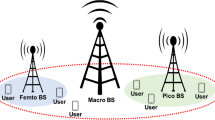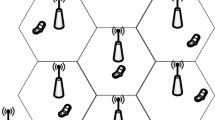Abstract
Future wireless networks are expected to be heterogeneous with dense deployed small cells to achieving an unprecedented system capacity. In the dense deployment scenario, interference manifests new feature and tend to be more bursty. Bursty interference leads to drastic variation of signal to interference and noise ratio (SINR) and hence affects users’ quality of experience (QoE). Generally, power control is utilized to compensate the SINR variation, which is energy-inefficient in the dense and complex network scenario. Therefore this paper focuses on the bursty interference management. An overview of existing SINR based power control techniques is firstly present. Then an network-level mechanism termed as opportunistic interference scaling (OIS) is proposed to efficiently smooth the bursty interference by decreasing the transmit rate of co-channel bursty, user driven (BUD) traffic. In addition, based on the proposed QoE model, a QoE aware energy efficiency metric is introduced to study the trade-off between QoE and energy consumption when adopting OIS. A QoE-Energy aware optimization problem is further formulated and the modified particle swarm algorithm is used to solve it. Numerical results show that the proposed QoE-energy aware OIS can smooth the link variation, and guarantee the target quality level with less power consumption at the cost of negligible QoE degradation for BUD traffic.











Similar content being viewed by others
References
3GPP, TR 36.912, v11.0.0. (2012). Feasibility study for further advancements for E-UTRA (LTE-Advanced) .
3GPP, TS 36.300. (2014). Evolved Universal Terrestrial Radio Access (E-UTRA) and Evolved Universal Terrestrial Radio Access Network.
Chandrasekhar, V., Andrews, J. G., Muharemovict, T., Zukang, S., & Gatherer, A. (2009). Power control in two-tier femtocell networks. IEEE Transactions on Wireless Communications, 8(8), 4316–4328. doi:10.1109/TWC.2009.081386.
Cheng-Xiang, W., Haider, F., Xiqi, G., Xiao-Hu, Y., Yang, Y., Dongfeng, Y., et al. (2014). Cellular architecture and key technologies for 5g wireless communication networks. IEEE Communications Magazine, 52(2), 122–130. doi:10.1109/MCOM.2014.6736752.
Egger, S., Hossfeld, T., Schatz, R., Fiedler, M. (2012). Waiting times in quality of experience for web based services. In Quality of Multimedia Experience (QoMEX), 2012 Fourth International Workshop (pp. 86–96). doi:10.1109/QoMEX.2012.6263888.
Enderes, T., Khoo, S. C., Somerville, C. A., & Samaras, K. (2002). Impact of statistical multiplexing on voice quality in cellular networks. Letters in Mathematical Physics, 55(1), 153–161.
Fiedler, M., Hossfeld, T., & Tran-Gia, P. (2010). A generic quantitative relationship between quality of experience and quality of service. IEEE Network, 24(2), 36–41. doi:10.1109/MNET.2010.5430142.
Haijun, Z., Chunxiao, J., Beaulieu, N. C., Xiaoli, C., Xiangming, W., & Meixia, T. (2014). Resource allocation in spectrum-sharing ofdma femtocells with heterogeneous services. IEEE Transactions on Communications, 62(7), 2366–2377. doi:10.1109/TCOMM.2014.2328574.
Ji-Hoon, Y., & Shin, K. G. (2011). Adaptive interference management of ofdma femtocells for co-channel deployment. IEEE Journal on Selected Areas in Communications, 29(6), 1225–1241. doi:10.1109/JSAC.2011.110610.
Kucera, S., Aissa, S., & Yoshida, S. (2010). Adaptive channel allocation for enabling target sinr achievability in power-controlled wireless networks. IEEE Transactions on Wireless Communications, 9(2), 833–843. doi:10.1109/TWC.2010.02.090574.
Madan, R., Borran, J., Sampath, A., Bhushan, N., Khandekar, A., & Ji, T. (2010). Cell association and interference coordination in heterogeneous lte-a cellular networks. IEEE Journal on Selected Areas in Communications, 28(9), 1479–1489. doi:10.1109/JSAC.2010.101209.
Monemi, M., Asli, A., Haghighi, S., & Rasti, M. (2013). Distributed multiple target-sinrs tracking power control in wireless multirate data networks. IEEE Transactions on Wireless Communications, 12(4), 1850–1859. doi:10.1109/TWC.2013.021213.121078.
Monserrat, J., Fallgren, M. (2013). Deliverable d6. 1 simulation guidelines. METIS.
Phatak, S., & Rao, S. S. (1995). Logistic map: A possible random-number generator. Physical review E, 51(4), 3670.
Rasti, M., Sharafat, A., & Zander, J. (2010). A distributed dynamic target-sir-tracking power control algorithm for wireless cellular networks. IEEE Transactions on Vehicular Technology, 59(2), 906–916. doi:10.1109/TVT.2009.2035627.
Rec, I. (1996). P. 800: Methods for subjective determination of transmission quality. International Telecommunication Union, Geneva.
Reichl, P., Egger, S., Schatz, R., D’Alconzo, A. (2010). The logarithmic nature of QoE and the role of the Weber-Fechner Law in QoE assessment. In Communications (ICC), 2010 IEEE International Conference (pp. 1–5). doi:10.1109/ICC.2010.5501894.
Rugelj, M., Sedlar, U., Volk, M., Sterle, J., Hajdinjak, M., & Kos, A. (2014). Novel cross-layer qoe-aware radio resource allocation algorithms in multiuser ofdma systems. IEEE Transactions on Communications, 62(9), 3196–3208. doi:10.1109/TCOMM.2014.2347288.
Sedlaczek, K., Eberhard, P. (2005). Constrained particle swarm optimization of mechanical systems. In Proceedings of the 6th WCSMO, Rio de Janeiro, Brazil.
Sedlaczek, K., & Eberhard, P. (2007). Augmented lagrangian particle swarm optimization in mechanism design. Journal of System Design and Dynamics, 1(3), 410–421.
Sharma, N., Tarcar, A. K., Thomas, V. A., & Anupama, K. (2012). On the use of particle swarm optimization for adaptive resource allocation in orthogonal frequency division multiple access systems with proportional rate constraints. Information Sciences, 182(1), 115–124.
Singh, S., & Andrews, J. (2014). Joint resource partitioning and offloading in heterogeneous cellular networks. IEEE Transactions on Wireless Communications, 13(2), 888–901. doi:10.1109/TWC.2013.120713.130548.
Singh, S., Andrews, J. G., & de Veciana, G. (2012). Interference shaping for improved quality of experience for real-time video streaming. IEEE Journal on Selected Areas in Communications, 30(7), 1259–1269.
Soret, B., Pedersen, K. I., Jorgensen, N. T. K., & Lopez, V. (2015). Interference coordination for dense wireless networks. IEEE Communications Magazine, 53(1), 102–109. doi:10.1109/MCOM.2015.7010522.
Strinati, E., De Domenico, A., Duda, A. (2011). Ghost femtocells: A novel radio resource management scheme for ofdma based networks. In IEEE Conference on Wireless Communications and Networking (WCNC) (pp. 108–113). doi:10.1109/WCNC.2011.5779115.
Tamura, H., Yahiro, Y., Fukuda, Y., Kawahara, K., Oie, Y. (2007). Performance analysis of energy saving scheme with extra active period for lan switches. In IEEE Conference on Global Telecommunications, GLOBECOM ’07 (pp. 198–203). doi:10.1109/GLOCOM.2007.45.
Thakolsri, S., Kellerer, W., Steinbach, E. (2011). Qoe-based cross-layer optimization of wireless video with unperceivable temporal video quality fluctuation. In 2011 IEEE International Conference on Communications (ICC) (pp. 1–6). doi:10.1109/icc.2011.5963296.
Xu, J., Zhang, J., & Andrews, J. (2011). On the accuracy of the wyner model in cellular networks. IEEE Transactions on Wireless Communications, 10(9), 3098–3109. doi:10.1109/TWC.2011.062911.100481.
Yang, M., Groves, T., Zheng, N., & Cosman, P. (2014). Iterative pricing-based rate allocation for video streams with fluctuating bandwidth availability. IEEE Transactions on Multimedia, 16(7), 1849–1862. doi:10.1109/TMM.2014.2343943.
Yeh, S. P., Talwar, S., Himayat, N., Johnsson, K. (2010). Power control based interference mitigation in multi-tier networks. In IEEE GLOBECOM Workshops (GC Wkshps), 2010 (pp. 701–705). doi:10.1109/GLOCOMW.2010.5700413.
Zhao, Y., & Haggman, S. G. (2001). Intercarrier interference self-cancellation scheme for ofdm mobile communication systems. IEEE Transactions on Communications, 49(7), 1185–1191. doi:10.1109/26.935159.
Author information
Authors and Affiliations
Corresponding author
Rights and permissions
About this article
Cite this article
Chen, Y., Lu, Z., Wen, X. et al. QoE-Energy Aware Opportunistic Interference Scaling in Dense Heterogeneous Networks. Wireless Pers Commun 92, 1801–1827 (2017). https://doi.org/10.1007/s11277-016-3635-8
Published:
Issue Date:
DOI: https://doi.org/10.1007/s11277-016-3635-8




